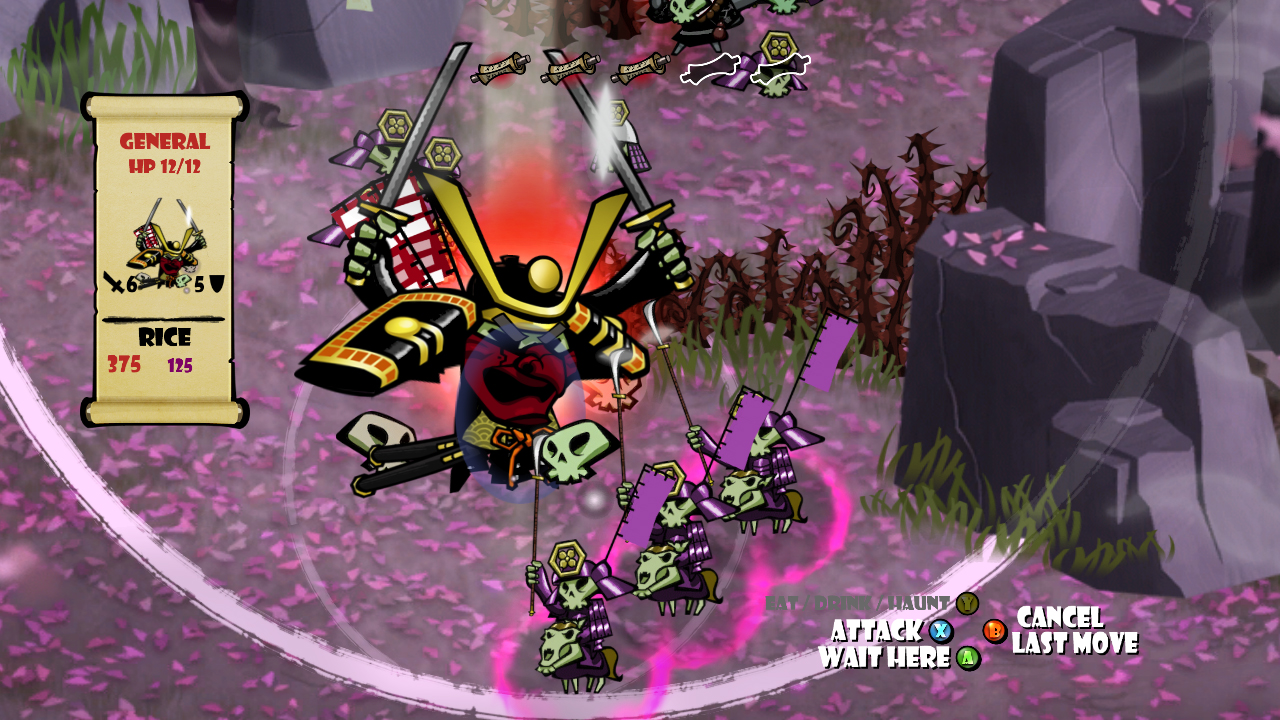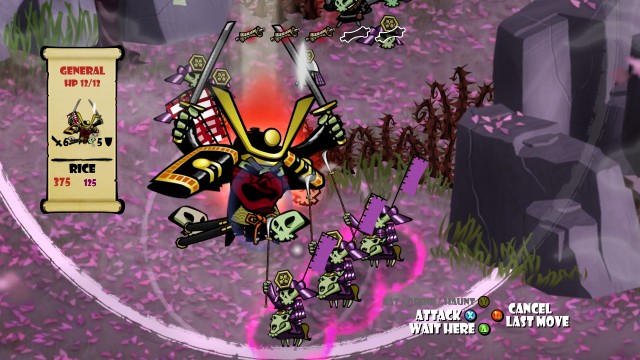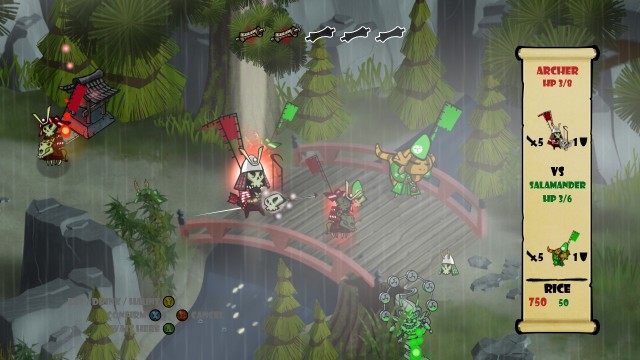Interview: Skulls of the Shogun dev on asynchronous multiplayer and XBLA
It’s 30-minutes til the doors slam shut on day two of Rezzed; Brighton’s PC and indie games soiree featuring the likes of Gunpoint, Hotline Miami and, of course, Skulls of the Shogun. Hot stuff, but it’s no doubt to the chagrin of Borut Pfeifer – developer at 17-Bit – that I’ve asked him to describe Skulls in just 20 words at this late juncture.
“It’s turn-based strategy infused with the spirit of an action or arcade game. It’s fast, no grid, with multiplayer.” Nailed.
Skulls of the Shogun marks 17-Bits’ attempt to haul the turn-based strategy shenanigans of something like Advance Wars (possibly the greatest game ever made) onto Xbox Live Arcade. No easy feat; the Xbox is without touch screen, without keyboard and mouse and about the only example I can think of turn-based strategy game built solely for XBLA is Band of Bugs. Gulp.
With that in mind, I chat with Borut about how Skulls has been tailored to XBLA, why 17-Bit chose the platform and, mostly, the intricacies of the recently announced asynchronous multiplayer. What’s an asynchronous multiplayer? Read on!
Arcade-action seems to be the buzzword for Skulls of the Shogun, what exactly does that entail?
There are a few things that boils down to. One, the interface has to be really easy to get. However complicated it is, it has to be easy to grasp and it has to be fast to use. Most games in this genre have seven layers of menus and then you finally do your action. You pick an action, and then you pick an attack and then you pick your sword and then you pick the person and then you pick their limbs or whatever, and it’s just ridiculous.
The last thing is just the drama of it. It’s an arcade game – you’re always on the edge of your seat, if you die you’re going to have to put in more quarters – there’s inherent drama to it so we wanted, especially with the multiplayer, to have a lot of dynamic back and forth. It’s designed as such so that you really have to stay on your toes. Sometimes it looks like one player has a huge advantage but all they have to do is mess up once and the opposing player can step in and take advantage of that. That makes for a very dramatic multiplayer set up.
Is there still enough there to appeal to the seasoned strategy player?
We definitely hope so. We think the depth is there. Once people play it for long enough – even ten to 15 minutes – they get that there’s depth there. There’s a lot of finesse elements. Something like the knock-back, for example, is based on your position relative to the target so if you’re closer you do more knock-back and there’s this sense that ‘oh I want to get in the right position’ or ‘I want to edge him out.’ There’s depth for the people who are looking for it.
Tell us a little about the asynchronous multiplayer feature you’ve recently announced.
You’ll be able to play asynchronously on XBLA, Windows 8 and Windows Phone. You’ll get notifications even if you’re not in the game that it’s your turn or you’ve received an invite to a game and you’ll be able to pop into the game, start your turn and it’ll get sent off. So wherever you are, if you have the game on multiple devices those games transfer seamlessly.
We’re really excited. Especially on Xbox, there’s nothing of it’s kind like that. We think it’s pretty cool, you might be watching a movie or something and you see the message that it’s your turn so you pop in, you play your turn and then you go watch your movie and maybe by the end you have another turn to play. Or you can have ten games running and play ten turns.
So you could start playing on the Xbox, then flick over and watch a movie on Netflix while continuing on the Windows tablet?
Yeah, exactly.
How did the asynchronous multiplayer come about? It seems like the perfect marriage – snappy rounds played anywhere. Was it something Microsoft approached you about or vice-versa?
Our original producer at Microsoft, Robby Zinchak, mentioned that they were working on this tech, a server backend to play async games, and asked if we were interested in using it. To us, it just seemed like a great idea, so we jumped at the chance. We’ve always wanted to remove barriers for players trying to get into the game and letting players play whenever they want on any device does just that.
A lot of indie multiplayer games struggle to reach critical mass with the number of people playing online – you need to have a big enough community such that people can always find others to play with. So having all these platforms, being able to play across them asynchronously, we’re hoping will really help our chances.
So did the decision to include async multiplayer impact the design process?
It was mostly a technical thing – we didn’t change the design of the game much. The one difference is that you can’t use round time limits in Skulls Anywhere mode since that doesn’t really make sense. That does take away the party-mode style of play as an option in Skulls Anywhere – but the ability to play wherever/whenever was worth it to us, and that option still exists for local and realtime online play.
If we were starting from day one with both async and realtime multiplayer, that might have theoretically sent us in different directions, but we’re pretty happy where we ended up regardless. I think the game works better as a cross-platform game now because we spent all our time early on making turn based strategy game fast paced & action oriented for consoles. That kind of gameplay is more common on phones, tablets, and desktops, so if we started with an async game there and tried to bring it to consoles, it probably wouldn’t work as well on all of them.
Were there any difficulties creating the game for several devices or any concessions that had to be made?
It’s pretty close to the same game. The biggest technical concessions were on the phone – images are half resolution, but then again, so is the screen. There’s also some other minor background effects that are simpler. We don’t think people will notice those too much on the phone.
Windows 8 was more of a challenge to port to, since we use XNA and that’s not supported for Metro apps that target both the tablet and the desktop. There’s an open source version of XNA, called MonoGame, so we had to port that to Win 8 to get us up and running.
The other difference is that the Xbox version is the only one with realtime online play. That’s because Microsoft doesn’t at the moment provide that networking option for Xbox Live on Windows 8 and Windows Phone – if they do in the future though we’d love to add realtime online play to those versions in an update.
So not a ton of concessions, thankfully. Just a lot of hard work getting ready to ship 3 platforms with only 2 full time programmers.
Do you see async multiplayer as a feature more XBLA games will take advantage of in the future?
Absolutely. It’s not something that’s a great fit for all games, but I think especially on Xbox it will become more and more popular. While async multiplayer is obviously already a fit for phones & tablets, I think people will find it fits with the way they play on the Xbox too.
Overall, with both async multiplayer and SmartGlass, the possibilities for asymetric gameplay are exciting. It’s a hard design problem, so I don’t know how many bigger developers will be able to do the R&D and iteration it takes to do make something that stands out. For a small developer though, as long as there’s an audience, the opportunity to do something innovative there is very cool.
So to take advantage of async multiplayer, will people have to buy the game multiple times on multiple devices or just the once?
That’s obviously what we’d like to do but it’s mostly in Microsoft’s hands; the stores have to support that functionality. We don’t know for sure, we don’t think it’ll be there at launch but hopefully it will be at some point in the future. The Xbox store is based on points and the Windows store is based on money but the Xbox store will be moving to money. Eventually, when that’s all aligned, it should be able to do that.
Finally, what drew you to XBLA as a platform?
That’s where we play a majority of online games with our friends. We’ve all gotten tired of shooters, since they don’t really let us talk to our friends while we play, and there’s so many good games on XBLA for that, like Castles Crashers or now Spelunky. But there wasn’t anything for folks who wanted a bit more thinking involved or whose reflexes suck and have degraded with age like most of our team.
We were pretty confident folks playing on XBLA would get our gameplay and it would appeal to them in similar, but somewhat different, ways. Just having that multiplayer community there, as a pool of potentially interested players, we thought was going to be important to succeed. Like I mentioned earlier, that’s often a big challenge for multiplayer games of this size.
Expect to hear more about Skulls of the Shogun as we edge nearer the launch of Windows 8.



